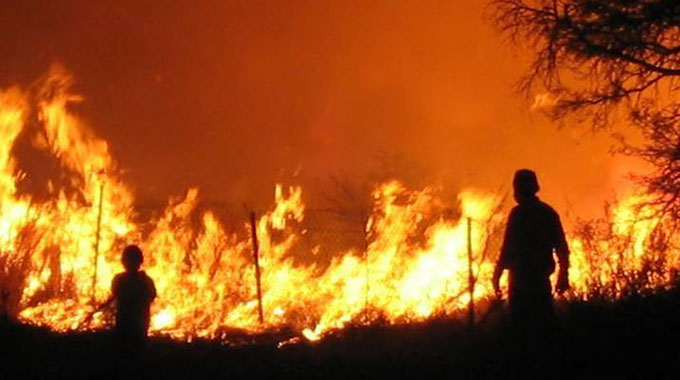EDITORIAL COMMENT: Step up fire prevention measures

The deaths of 10 men fighting a fire on Rodrose Farm in Esigodini on Monday with four more surviving, but with serious injuries from burns highlights both the dangers of veld fires and the need for standard procedures.
When all is said and done, property can be replaced, veld will regrow, compensation can be paid for destroyed crops or dead livestock, but a human life cannot be replaced.
So what worked last time there was a fire might not work the next time. Winds can suddenly start blowing harder, winds can change direction, sparks can fly over a road or firebreak and start a new blaze cutting off retreat.
Among all the measures we already have in place, alerting the public to the danger of fire, the ease of starting a major fire, the need for fireguards on all farms, we must also tell people the best way of escaping a fire, and if there is a decision to fight a fire how we can have safe routes for escape if something goes wrong.
The 10 are not the only deaths from veld fire in this present hot dry season. Another eight people were caught by fire and died, even though they were most probably trying to escape the fire.
The first need is not to have accidental or uncontrolled fires in the first place. If there is no fire then no one gets hurt, no one is killed and no property, crops or pasture are destroyed. And fire prevention needs to be pushed a lot harder.
We get an idea of the scale of carelessness when we look at our road verges as the dry season advances, and at the number of fires that seem to start from a road.
The Environmental Management Agency has estimated that around 60 percent of fires start within 500m of main road.
A lot of these are caused by smokers just tossing their cigarettes out of a vehicle window or dropping them on the verge as they walk. While modern cigarettes are designed to extinguish themselves fairly soon, the glowing tip landing on some dry tinder, and there is a lot of this around at this time of year, can easily be puffed into flame.
For a start, smokers need to understand they are a walking or driving danger and make sure the thing is definitely out before they dump it. Some strongly anti-litter countries, such as Singapore and Namibia, classify a cigarette butt as litter and smokers who want to escape a fine or the contempt of their fellow citizens not only have to put it out first, but then carry the butt to a bin. Car smokers should use ashtrays; pedestrians can at least bury the butt.
Truck crews in particular, but other drivers can be as bad, like to stop on the side of the road and boil up a cup of tea. We used to have functional lay-bys on our highways, with a fireplace on bare earth and a rubbish drum, and that worked.
These days people stop anywhere there is a reasonably wide verge, and some do not bother to put out their fire properly.
We have people burning garbage near a road, which is wrong, and then leaving it smouldering, which is worse. And so it goes. It is easy to see where that 60 percent comes from.
Then we have other deliberate fires, not arson but inexpert and inexperienced people using fire. Some farmers use fire to clear land; we see a lot of this in urban areas for those little maize patches and it is not unknown in rural areas.
We have farmers who want a controlled burn on pasture to improve grazing later on, but these controlled burns are supposed to be done under rigorous conditions are supposed to be “cool” burns, done very early in the season. Some of these fires get out of control.
Some hunters use fire, and are less fussed about the effects. People light a fire to smoke out bees. All this adds up.
Creating fireguards, again early in winter soon after the rains, can involve some very careful burning, but the farmer or landholder is supposed to cut vegetation first, put in the clear strips each side, have transverse breaks at intervals and choose a still day with zero wind. Done properly it is generally safe, but not all farmers are that good.
Fireguards are a legal requirement. Ploughing is the safest, but some controlled burning is permitted under the rules. And some landholders just do not bother.
Enforcement is getting better, a lot better. The EMA, after some years of very little activity became very activist last year in handing out tickets and is doing even more this year. The police are now appealing to the public to report someone starting a fire for any reason.
Landowners needing controlled burning for fireguards or land clearance are supposed to tell their local station six weeks in advance, so the public can in good conscience report.
If the fire is permitted the police already know and can thank the conscientious person reporting, but do not need to waste time, and if it is not then action can be taken promptly.
Now we come to another problem, what caused Monday’s tragedy. Farmers and other landholders are supposed to fight fires where possible, and generally want to so they can minimise damage.
Neighbours are in most communities willing to help and can be mobilised. This is important.
But at the same time someone in the firefighting teams needs to know precisely what risks are acceptable and what are not. Someone needs to figure out, in advance, where are the escape routes if something goes wrong, generally upwind or to the side of the fire.
No one should ever have to try and outrun a fire. Even a fireguard or a narrow road downwind of a fire might not be a safe fighting line, although these to the side of a fire can usually be defended.
The EMA is doing a lot more training, mainly in protecting land, and needs to advance this so that in the end all land is protected and all fires can be small.
But at the same time the EMA and farmer organisations need codify best and safe practices and get this out to the farmers. And they need to ensure that at least one person in each community has maximum knowledge of fighting a veld fire and can take charge, do what can be done safely and prevent any rash heroism. It is totally wrong that anyone should be placed in unacceptable danger.
So we have our cut out. We need a lot fewer fires, so we must all be conscious of the risks and not cause fires in the first place.
Landholders and farmers must protect their land, so when a fire does break out just one field is lost. And this must be done properly and safely.
And we need to know how to fight fires, as effectively as possible but far more importantly how to do this in safety, even when something goes wrong.









Comments